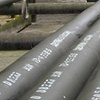
High-frequency welded pipe production process
تاريخ:2017-12-27
رأي:2506
High-frequency welded pipe production process depends mainly on product variety, from raw materials to finished products need to go through a series of processes, the completion of these processes require a corresponding variety of mechanical equipment and welding, electrical control, testing devices, these devices and devices according to different processes. The process requires a variety of reasonable arrangements, the typical process of high-frequency welded pipe: unwinding - strip leveling - head and tail shear - steel butt welding - looper storage - forming - welding - removal of burrs - sizing - flaw detection - initial inspection - steel straightening - pipe processing - hydrostatic testing - flaw detection - printing and coating - finished products.
High-frequency welding is the use of high-frequency current flowing through the continuous contact surface of the workpiece due to the heat generated by the heat and the application of the top forging force, the workpiece metal to achieve a mutual welding of a class of welding methods. It is similar to normal resistance welding, but there are many important differences. High-frequency welding has a large power supply, for different materials, caliber and wall thickness of the pipe can reach a higher welding speed (higher than the maximum welding speed of argon arc welding lO times higher). Among them, raw materials accounted for 32.44%, welding process accounted for 24.85%, roll adjustment accounted for 22.72%, the three accounted for 80.01%, is the main link. If the induction ring away from the squeeze roller farther, the effective heating time is longer, heat affected zone wide, making the strength of welded steel pipe decreased or incomplete penetration; the other hand induction ring easy to burn squeeze roller.
High-frequency welding is the use of high-frequency current flowing through the continuous contact surface of the workpiece due to the heat generated by the heat and the application of the top forging force, the workpiece metal to achieve a mutual welding of a class of welding methods. It is similar to normal resistance welding, but there are many important differences. High-frequency welding has a large power supply, for different materials, caliber and wall thickness of the pipe can reach a higher welding speed (higher than the maximum welding speed of argon arc welding lO times higher). Among them, raw materials accounted for 32.44%, welding process accounted for 24.85%, roll adjustment accounted for 22.72%, the three accounted for 80.01%, is the main link. If the induction ring away from the squeeze roller farther, the effective heating time is longer, heat affected zone wide, making the strength of welded steel pipe decreased or incomplete penetration; the other hand induction ring easy to burn squeeze roller.

























